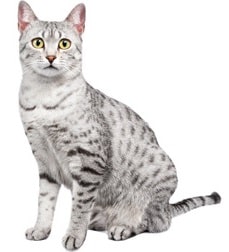Type the name of the breed you're looking for below
[wpdreams_ajaxsearchlite] Don't see the breed your're looking for? Click here and let us know!
Breed Characteristics
1 paw - breed exhibits the least amount of this characteristic
5 paws - breed exhibits most amount of this characteristic
Egyptian Mau
| Origin And History | The Egyptian Mau is one of the oldest existing breeds of domestic cat, and the only naturally spotted one. Evidence in the form of depictions, paintings, and sculptures shows that spotted cats existed during the time of the Egyptian cat cult, and it is theorized that the predecessor of the Mau was the very same cat worshiped by the ancient Egyptians. A papyrus painting dating around 1100 B.C. shows Ra in the form of a spotted cat beheading the evil serpent Apep. In 1580 B.C., a papyrus record quotes a spotted cat as saying, 'I am the cat which fought near the Persea Tree in Annu on the night when the foes of Neb-er-tcher were destroyed!' On a more mundane note, a 1400 B.C. tomb painting found in Thebes depicts a spotted cat retrieving a duck for an Egyptian hunter, showing that cats were not only worshiped but played an important role in everyday life as well. Egyptian Maus joined the European cat fancy in the early 1900s. Fanciers in Italy, Switzerland, and France worked to develop the breed; however, as it did many purebred breeds, World War II decimated the Egyptian Mau population and by the mid-1940s the Mau was almost extinct. The efforts of the exiled Russian Princess Nathalie Troubetskoy brought the Mau back from the brink of extinction. While in Italy, she rescued some of the few remaining specimens. She was also instrumental in importing at least one Mau from Egypt via the Syrian Embassy. In 1956 Troubetskoy immigrated to the United States, bringing with her three Maus bred from her original stock. Upon arrival, Troubetskoy began her own Egyptian Mau cattery (Fatima) and began to promote the breed. The Mau soon collected a following of fanciers who wanted to preserve the rare and historically significant breed. Because of the small gene pool and because additional Maus were almost impossible to obtain from Egypt, a certain amount of inbreeding and outcrossing were required to continue the breed in North America. Selective breeding for temperament was also a priority, since disposition problems were noted in some bloodlines. Finally, in the 1980s breeder Cathie Rowan brought 13 additional Maus into the United States, paving the way for more imports. In 1991 breeder J. Len Davidson imported four more. This widening of the gene pool was vital to the breed's health and well-being. |
| Personality | While fanciers might at first be attracted to the Egyptian Mau's beautiful spotted coat, most become enthusiasts because of the breed's temperament and personality. Maus, like their ancestors that were invited along on the duck hunts of their Egyptian companions, love to fetch. In fact, they love any play activity that mimics hunting behavior, and if allowed outside will become very competent (some might say savage) hunters. That's not to say they are not devoted to the humans who pay them homage. Fanciers describe them as fiercely loyal cats that generally don't take to strangers. Once they bond with their human companions, they choose to be worshiped by their own family, rather than by the entire human race. While not overly talkative, Maus will let their family know if something is amiss, particularly if that something concerns their food dishes. Their voices are usually melodious and quiet. When engaged in conversation with their human companions, Maus wag their tails, tread with their feet, and make a variety of sounds that fanciers call 'chortling'. |
Physical Attributes
| Appearance | Egyptian Maus typically are slender and muscular and they are thought to be one of the progenitor breeds of the modern domestic cat. They have anatomical, metabolic, and behavioral differences from other cat breeds which could be considered evidence of antiquity or at least uniqueness from other cat breeds. Some anatomical differences are their legs, which are slightly shorter in the front than in the back. They also have a skin fold under the belly, resembling that of the cheetah, which assists in running by allowing the legs to stretch back farther. Also one of the most important recognizable "traits" of this particular animal is a long, dark, dorsal stripe that runs from its head to its tail along its spine. Egyptian Maus will have either a 'scarab beetle' or 'M' marking on their foreheads, those with the latter tend to be from the United States. |
| Health | Maus are more temperature sensitive than most breeds - they are fond of very warm temperatures. They are more sensitive to medicines and anesthesia.[citation needed] Maus allegedly have an unusually long gestational period, about 73 days. The maximum normal period for cats is 65–67 days, although Siamese may take a day or two longer. Egyptian Maus are a relatively rare breed. As of 2007, fewer than 200 kittens are registered with the Governing Council of the Cat Fancy each year. As of 2006, a total of 6,742 Maus were registered with the Cat Fanciers' Association. |



